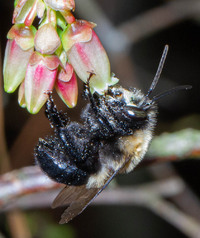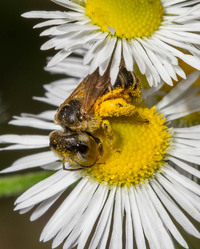How to Identify a Hymenopteran
Unlike several other websites that specialize in the identification of insects, we are primarily interested in figuring out the distributions, habitat associations, and conservation status of Hymenopteran species. Those goals themselves depend on accurately identified specimens, but we recommend that other sources be consulted first in order to come up with at least an initial identification (a preliminary species name is, in fact, required to submit a record). For each species, we provide a set of references – including links to identification website – to facilitate this process. Once an initial identification is made, you may then want to consult the Species Accounts in our website for the ecological information that we provide, as well as the standards we ourselves set for diagnosing a particular species.
FIELD GUIDES
Currently, there are no field guides that provide a comprehensive coverage of the Hymenoptera that occur in our area. Compared to birds, butterflies, mammals, and other groups that have been very successfully treated in field guides, there are simply too many species, too many variations within species, and too many closely similar species among Hymenoptera to be handled by a single book (especially one small enough to be taken out into the field). There are, however, guides that cover selected groups within this very large order of insects or that provide keys for the identification of families, subfamilies, tribes, and genera. Three that we recommend are:
Bumble Bees of North America: An Identification Guide, by P.H. Williams, R.W. Thorp, L.L. Richardson, and S.R. Colla; Princeton University Press. This book covers all of the Bumble Bee species found in our area, providing identification keys, range maps, and details about habitats and life histories
The Bees in Your Backyard. A Guide to North America's Bees, by J.S. Wilson and O.J. Carrill, Princeton University Press. This is a comprehensive guide to all of the families, subfamilies, and genera of the bees that occur in North America and provides a great deal of information on the taxonomy, ecology, and life histories of our bee fauna.
The Bees of North Carolina: An Identification Guide, by H. Levenson and E. Youngsteadt, NC State Extension Service. The families and genera of the common bees that occur in North Carolina are illustrated in this guide, along with their diagnostic features. The number of species occurring in North Carolina is given for each included genus, along with information on their phenology, life history, and behavior.
WEBSITES
While field guides are still good places to start, especially to identify a Hymenopteran to family, subfamily, or genus, internet websites are able to handle more species, provide more information per species, and can be updated more rapidly. There are now several websites that specialize in providing identifications about Hymenopterans, with the following three that are particularly useful for identifying a species from scratch.
BugGuide is a key resource for identifying all terrestrial arthropods. BugGuide provides a lot of information for each species (not all of which is yet filled in for any given species). It also has a scanning function (Browse) that allows fairly rapid comparison between the specimen to be identified and potentially matching species. In BugGuide’s version, browsing for matches can be done hierarchically, starting at any taxonomic level between Superfamily and Genus, and then successively narrowing the choices. For example, if you know that your Hymenopteran belongs to the Hornet family (Vespidae), you can start at that level and narrow it down first to subfamily, then to tribe, then to genus, and finally to a particular species. This approach is not only useful for someone who knows little, if anything, about Hymenopteran taxonomy, but also provides an efficient way of searching for someone with more experience, who can start the process much lower down in the hierarchy (the authors of this website make frequent use of this service).
Where no apparent match can be made through this process, BugGuide also offers to identify photos of unknown species (see ID Request). This is a free service and is done via collaboration with BugGuide’s existing members (joining BugGuide is free).
Discover Life is another major online source of information that covers a wide range of taxonomic groups. It's coverage of bee species is particularly thorough and we have relied upon it heavily as a source of current scientific names and taxonomic relationships for this group. It also provides multi-format keys (IDNature Guides) that allow identification of unknown species by simply checking a series of features, including geographic locations. For individual species, photographs are included and, particularly for some groups such as bees, range maps, records, and detailed descriptions are given.
iNaturalist is a third source of records and like BugGuide, relies on records submitted by the public and a community approach to vetting, often involveing the participation of taxonomic experts. Increasingly, taxonomic, ecological, and conservation information is being written in the form of individual species accounts.
TECHNICAL LITERATURE
With so much individual variation and the large number of closely similar species found among Hymenopterans, identification often requires measurements or the examination of smaller or more hidden morphological structures than are usually visible in photographs. In some cases, these features are described in the text of the field guides or websites but typically they are not mentioned at all. For our purposes, however, we need as precise identifications as possible, sometimes requiring the use of more detailed information available only in the underlying taxonomic literature, i.e., the same information used by taxonomists or collection curators to sort and assign specimens according to the features by which they were originally described.
For bees, the detailed technical descriptions and keys provided by T.B. Mitchell’s the Bees of the Eastern United States is the most comprehensive source currently available. The sections covering the various families are available online at the NCSU Insect Museum’s website (Bees of the Eastern United States). For individual species, descriptions are also excerpted on the account pages on the Discover Life website.
For the more obscure groups – unfortunately including many of the non-bee Hymenoptera– the original descriptions of a species may need to be sought out (although some, at least, are now available online; BugGuide is a good place to look for links). More useful are references that summarize the technical information at higher levels, e.g., genus or family. Most useful of all are those that provide dichotomous keys, based on diagnostic features that allow precise discriminations to be made between species.
SPECIMEN-BASED IDENTIFICATION
If you are fortunate enough to live near a large reference collection, such as the Insect Museum at NC State University, direct comparison of a specimen to those identified in the collection offers one of the most traditional means of determining an unknown species. Specimens can also be taken to county extension service for identification or shipped to the NC State University Plant Disease and Insect Clinic.
Individual members of the North Carolina Biodiversity Project may also be willing to identify collected specimens, but usually only where a specimen would be particularly interesting taxonomically or where its occurrence would be new for either the state as a whole or for a particular region or habitat type (see Contacts for more information).
|


 on the left, or to the next species in the checklist order by clicking on the Megachile
on the left, or to the next species in the checklist order by clicking on the Megachile on the right. You can also get to additional species by entering text in either of the Search Common or Search Scientific boxes; click on the full species name; then click on the blue Find tab. A third way to get to another species (within the same Family) is to click the down arrow under the scientific name, where the box shows other members in the Family; click on the species of interest.
on the right. You can also get to additional species by entering text in either of the Search Common or Search Scientific boxes; click on the full species name; then click on the blue Find tab. A third way to get to another species (within the same Family) is to click the down arrow under the scientific name, where the box shows other members in the Family; click on the species of interest.